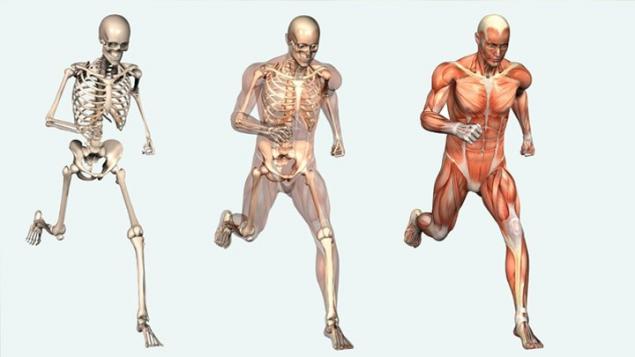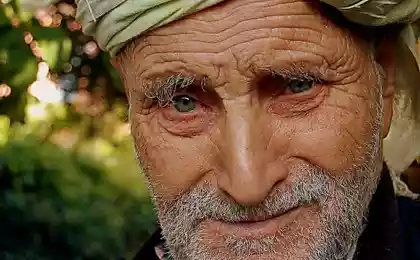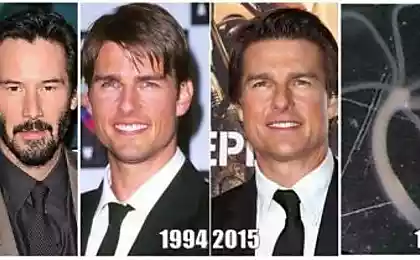858
Growth hormone: hormone of stress and aging
The name "growth hormone" (GH) may be misleading. In the process of so-called "hormesis" stress leads to somatic growth. Physical exercises cause the swelling in the muscles is the same as under the action of growth hormone; stimulates the growth of the swelling. GR does not limit his field of influence by the skeleton and muscles.
We identify G: molecular ambiguity, complex changes transformerait one substance in many others; biochemical evolution of GR suggests the hypothesis of its role in the regulation of the water complex of the body. The doctrine of "specific molecule", "receptor-specific" or "specific action" is simply a myth.

One of the Central issues when the stress is, in other words — how to keep the water under control. In mammals, the major regulators and controllers of the water balance are the kidneys and bowels.
GR is the stress hormone. Its effect can be played osmotically, for example, stimulating milk production or the growth of cartilage by osmotic shock (dilution, dilution).
Estrogen leads to high levels of GR increases its production in stress conditions.
Nitric oxide is a free radical that contribute to aging of the organism, stimulated by estrogen and lead to the release of GR, all three of these actions lead to swelling.
For edema, hypoxia and hypocapnia — free fatty acids, diabetes, increased vascular permeability, degenerative changes in the kidneys, changes in the connective tissue, thickening of the basal membrane, degeneration of the retina. The same changes occur with aging: increased permeability, kidney disease, changes in the connective tissues.
The lack of GR protects the kidneys from degeneration. Osteoarthritis, characteristic of the aging process, called estrogen and GRS.
Some studies have shown that GH does not improve conditions of heart failure and bone regeneration. The level of GH in heart failure is very high, resulting in swelling contributing to the problem. Therapy with G led to the emergence of carpal tunnel syndrome, myalgia, growing tumors, gynecomastia, and other issues associated with GRS.
To increase milk production to give cows bovine growth hormone. It is believed that human growth hormone will make a person lean and muscular, not will cause increased milk production.
I recently heard an interview with Robert Zapolskogo, in which he described the changes associated with training the body to short term stress. He said that mobilizing the energy hormones, adrenaline and cortisol, increase, while hormones are not involved in immediate response to the problem, including sex hormones and growth hormone, are suppressed in order to save energy. Growth and reproduction can wait a few minutes during phases of acute stress, allowing the body to more efficiently gather the necessary strength. And he repeated: stress suppresses growth hormone.
Have Zapolskogo there is a very interesting work dealing with the suppression of testosterone under stress and ways of destruction of brain cells as a result of prolonged exposure to glucocorticoids. He showed that if provided with additional feed of glucose, the brain cells can survive prolonged exposure to cortisol. Adrenaline and glucocorticoids increase the level of available glucose.
Within a radio interview that he wasn't able to go into the details, but it seemed to me that he says is not about the HGH, which I did a lot of reading and thinking, trying to understand. I was asked to write about the modern use of GH in anti-aging, its use in the dairy industry, and approval Zapolskogo got me thinking about some questions related to this hormone. (If Sapolsky only talked about rats and mice, his statement in General, it would be quite correct. Rats epinephrine stimulates G cells of the pituitary gland. And because both substances lead to an increased level of free circulating fatty acids, it is possible that GH in rats inhibit elevated concentrations of fatty acids.)
Growth hormone this hormone began to be called long before it was received, and found that a substance with such a name involved, in addition to growth in many other processes. It is given to cows to boost milk production, it is prescribed to people to make them slim and muscular and with a view to building stronger bones.
It is not surprising that growth hormone promotes breast development and milk production, as it is close to prolactin. GH and prolactin are members of one family of proteins that diverged in evolution, but still demonstrate similar properties.
When growth hormone is considered as a medicinal product, it is assumed that it should be inherent discrete identity, which is based on the sequence of amino acids. But the natural hormone (not taking into account the existence of related peptides that have minor differences in amino acid composition) varies in time, it undergoes chemical modification before secreted. For example, acidic amino acids may be methylated, lysine groups can be connected with sugars or carbonic acid. The path of development of this protein in the body determines its specific structure and hence the biological effect.
The male animals secrete G portions, and females — in a more continuous mode. This picture is the development of "masculinities" or "feminisim" liver (and other organs), determining the style of enzymatic activity. It is possible (though not easy) to arrange a feeding system in a pulsed, parivuodetta mode. Cows obviously don't need to, because the problem which is solved with the help of the growth hormone is to "feminize" the system of milk production. But the normal pattern of the hormone is significantly more complicated than just "pulsed" or "continuous", because, as in the case of prolactin, it is sensitive to changes in the thyroid gland, estrogen levels, nutrition, stress and many other factors.
For example, the hormones of this series, judging from the research, in the process of evolution was involved in the regulation of water and mineral substances. It is well known that increased water content (hypotension) stimulates the production of prolactin, and elevated levels of sodium — inhibits it. HGH is also closely involved in the processes of regulation of water and salts in the body.
One of the most well-known metabolic properties of growth hormone, like adrenaline, is its ability to retrieve from storage and executed in the case of fatty acids. It is known that GH is an antagonist of insulin, and one of the options of this confrontation is determined by the ability of fatty acids in high concentrations to block the oxidation of glucose. In pubertantnyy the period of increased G is a weak degree Diablo-like insulin resistance, which tends to progress with age.
In his book "Why zebras don't get ulcers" Sapolsky identifies some situations in which the person under stress, GR is growing, but I think it overlooks the real way it works under stress. One of the interesting properties of cortisol, as shown by Sapolsky, to kill brain cells, depriving them of the ability to efficiently metabolize glucose. Cortisol interferes with the process of energy production, forcing the cells to more easily digest unsaturated fatty acids. Because the growth hormone also has this kind of "diabetogenic" action would seem desirable to suppress its secretion during stress. In fact, there are several types of stress, during which there is a clear increase in its production. In a variety of organisms — fish, frogs, cows, and humans in particular — it plays a significant role in the regulation of water and salts in the processes of growth and development, stress and starvation.
It is known that the heat, hypoglycemia, running and some other types of shock stimulate the production of growth hormone, sometimes to values that are ten or twenty times higher than normal. Two types of stress that usually do not increase secretion of HGH — it's a cold and sensory deprivation. I believe that growth hormone, like prolactin, is a stress-induced hormone. That is why I say that if the endocrinologist such a high level as Sapolski, so misunderstood the role of growth hormone, what can we say about the common public who is even more easily confused in this matter, believing that growth hormone acts in some way only the muscles, fat and bones.
It turns out that to achieve normal growth (body length — translator's note), a normally functioning pituitary gland is not necessary (Kageyama has been, et al., 1998).
Denckla W. D. (W. D. Denckla) found that the hormones of the pituitary gland in some way speed up the process of aging. They block the action of thyroid hormone, decreasing the ability to consume oxygen and produce energy. Diablo-like state emerging in pubertantnyy period, implies a relative inability to metabolize glucose, which is an efficient source of energy (oxygen), which leads to a shift towards the preferential oxidation of fats that occurs a greater number of free radicals and inhibition of mitochondrial function.

Diabetes patients — although this condition is believed to determines the lost capacity of the cells to absorb glucose — the glucose is usually spend is wasted, producing lactic acid, even outside of "stress" condition or with sufficient effort, leading to the obvious anaerobic metabolism. The phenomenon of this sort, found in various animals sent Denkla in search of what he called DECO (decreasing consumption of oxygen) or the "hormone of death". Vladimir Dilman drew attention to a number of similar phenomena, but he stubbornly interpreted everything in terms of a great genetic program, and offered no solution beyond a mechanistic symptoms.
Simply increasing the content of free fatty acids in the blood will have an effect that is similar to the DECO, or the "hormone of death", but growth hormone carries more specific metabolic effects on the cells than just the increased influence on them from the fatty acids. This hormone creates a bias towards the oxidation of unsaturated fatty acids (Clejan and Schultz), in the process, which seemed specially pererastaet energy.
Growth hormone plays an important role in the process of puberty, affecting, for example, on ovarian function.
Denckla found that in animals, the removal of the pituitary gland led to a drastic slow down aging. He attempted to highlight the hormone death from the extract of the pituitary gland. And came to the conclusion that it was not prolactin, although the latter has some properties of the hormone of death. In his most recent publication known to me on this subject, he reported that it was not possible to allocate the hormone of death, but he is "at a fraction of prolactin". Because prolactinoma a family of rats contains at least 14 different peptides, not counting the numerous options that arise due to the different conditions of specific production, it is not surprising that attempts to single out one factor, endowed with the exact set of properties chronically the aging of the pituitary gland, were unsuccessful.
Experiments Dankly similar to the works of many other researchers, who found that changes in pituitary function are the driving force behind aging and degenerative diseases.
Menopause, for example, is the result of overactivity of the pituitary gonadotropins due to cumulative toxic effects on the hypothalamus from the estrogen.
A. V. Everitt in the book about the role of the hypothalamus and pituitary in the aging of reported studies, which showed that estrogen causes loss of elasticity in connective tissues, and progesterone, as it turned out, is the anti-estrogen factor in longevity. Later he made a series of experiments, very similar to what we did Denckla, and showed that deletion of the pituitary gland slows down the aging process. some experiments have indicated that factors of longevity is a family of prolactin and growth hormone. Removal of the pituitary has anti-aging effect, similar to that which occurs when you restrict supply. The pituitary hormones, especially prolactin, is highly responsive to food intake and growth hormone participates in the changes occurring in the connective tissue and kidney in diabetes and in the aging process.
Dwarf mouse mutant, called small, has only 5 to 10% of HGH compared to normal mouse and unusually high life expectancy.
The obtained set of experimental data, which show that prolactin and estrogen have synergistic effect in the formation of tissue degeneration, including cancer, and that their influence tends to lose its protective properties in the deterrent age. Estrogen stimulates the production of prolactin and growth hormone. Thirty years ago, scientists warned that the estrogen contraceptives may cause diabetes because they lead to chronically high levels of growth hormone and free fatty acids.
Estrogen leads to a slight delay in water loss of sodium in the body are formed gipotonicescie liquid. Because hypotension is a sufficient incentive for the production of prolactin, I have suggested that the effect of estrogen on the fluid in the body leads to stimulation of prolactin. In pregnancy, the fetus is under the influence of liquids, high gipotoniceski which can not be explained by estrogen and prolactin. Since GR reduces the concentration of salt in fish when they go out into the ocean from fresh water, then perhaps growth hormone could be a candidate for such a role during pregnancy.
The growth itself is common to all cells, but HGH its strongest influence only in certain tissues, particularly in cartilage. Gigantism and acromegaly, which is characterized by a continuous increase in bone and cartilage, that forms the basis of public interest in the growth hormone. In old age the cartilaginous structure of bones and ears continue to grow. The fact that to stimulate growth of the cartilage is quite simple dilution of the nutrient medium allows to suggest that growth hormone may act through its influence on water metabolism. Fish that enter freshwater from the ocean, pituitary hormones of this family help them to balance salt in the body in the new environment, but in the process of transition, they develop osteoporosis and deformed skeleton that resembles a gradually occurring during aging in other animals.
It is clear that the growth hormone causes swelling and thus takes part in caused by the recent pathological processes. Messages posted to increase the volume of extracellular water, but someone came to the conclusion that the increased muscle weight observed after administration of growth hormone, is the result of "growth", "since microscopic examination revealed no swelling".
To call such statements are incompetent is too weak. Before you begin any experiment, each student, a biologist or a biochemist must know that to determine the water content in the tissue follows by comparing the wet weight and weight after complete drying. Search tissue water with a microscope is an analog of what you do in the pharmaceutical companies to portray at least some activity.
Estrogen, growth hormone and nitric oxide tend to a holistic approach and, along with the free fatty acids increase the permeability of blood vessels. GH promotes leakage of albumin into the urine, which is a characteristic symptom of diabetes. Diabetes and the reception G thickened basement membrane — jelly-like substance that forms the basis for capillary cells. The reason for this is not known, but this thickening can be compensatiei, "patching up holes", in order to reduce the leakage of protein and fat.
Increased vascular permeability, not only involved in degeneration of the kidneys, but also contributes to brain swelling and possibly plays a role in "autoimmune" diseases.
Whatever the mechanism of action, today it is well established that GH is involved in degenerative processes in the kidneys, and the lack of GR and even the removal of the pituitary gland, protect the kidney.
Now, when a significant contribution of GR in degenerative kidney processes, you can more clearly interpret the results of experiments Denly and Everitt. Growth hormone may not be is the hormone of death, the search for which was busy Denkla, but in properties it is very close to him. Watched him antithyroid properties, and perhaps even the effect of obstacles to growth during pregnancy and when kidney disease.
In newborns, high rates of GR associated with smaller body size and slower growth; there is a study that the high content of GR is associated with shortness of breath, hyperventilation that occurs as a result of stress. You can expect to suppress the breath will be a shift in the direction diabetophobia oxidation of fatty acids, and chronically high rates of free fatty acids in blood serum lead to generalized anti-thyroid action. Under the action of G, the proportion of unsaturated fatty acids is growing, "under the direction" of estrogen there is a similar picture.
Growth hormone inhibits gonadotropin-induced progesterone secretion, which in turn can have an impact on the thyroid gland, and respiratory metabolism.
The growth G in the sleep process at first glance, it would seem, is absolutely contrary to the idea that growth hormone is a stress hormone. But in reality, other stress hormones, such as adrenaline, cortisol, and prolactin also tend to increase during the night. Thyroid function and progesterone drops during the night. I argued previously that the darkness is one of our main stressors. Trend GR to induce edema, swelling tissues, may play a role in the night increase in blood viscosity, because blood volume decreases due to leakage of fluid into the tissue. Another process with potentially deadly outcome, which increases with aging and under stress, is the penetration of bacteria from the intestine into the bloodstream; this process is enhanced and the influence of growth hormone.
Research of acute conditions clearly show that growth hormone is stressful and has a destabilizing effect. It is highly likely that chronically high levels of unsaturated fatty acids in the blood and increased vascular permeability throughout life create a cumulative effect, which Denckla attributed to the Hormone of Death. published
©Ray Pitre.S. And remember, only by changing their consumption — together we change the world! ©
Source: //ekiri22.blogspot.ru/2014/08/blog-post.html
We identify G: molecular ambiguity, complex changes transformerait one substance in many others; biochemical evolution of GR suggests the hypothesis of its role in the regulation of the water complex of the body. The doctrine of "specific molecule", "receptor-specific" or "specific action" is simply a myth.

One of the Central issues when the stress is, in other words — how to keep the water under control. In mammals, the major regulators and controllers of the water balance are the kidneys and bowels.
GR is the stress hormone. Its effect can be played osmotically, for example, stimulating milk production or the growth of cartilage by osmotic shock (dilution, dilution).
Estrogen leads to high levels of GR increases its production in stress conditions.
Nitric oxide is a free radical that contribute to aging of the organism, stimulated by estrogen and lead to the release of GR, all three of these actions lead to swelling.
For edema, hypoxia and hypocapnia — free fatty acids, diabetes, increased vascular permeability, degenerative changes in the kidneys, changes in the connective tissue, thickening of the basal membrane, degeneration of the retina. The same changes occur with aging: increased permeability, kidney disease, changes in the connective tissues.
The lack of GR protects the kidneys from degeneration. Osteoarthritis, characteristic of the aging process, called estrogen and GRS.
Some studies have shown that GH does not improve conditions of heart failure and bone regeneration. The level of GH in heart failure is very high, resulting in swelling contributing to the problem. Therapy with G led to the emergence of carpal tunnel syndrome, myalgia, growing tumors, gynecomastia, and other issues associated with GRS.
To increase milk production to give cows bovine growth hormone. It is believed that human growth hormone will make a person lean and muscular, not will cause increased milk production.
I recently heard an interview with Robert Zapolskogo, in which he described the changes associated with training the body to short term stress. He said that mobilizing the energy hormones, adrenaline and cortisol, increase, while hormones are not involved in immediate response to the problem, including sex hormones and growth hormone, are suppressed in order to save energy. Growth and reproduction can wait a few minutes during phases of acute stress, allowing the body to more efficiently gather the necessary strength. And he repeated: stress suppresses growth hormone.
Have Zapolskogo there is a very interesting work dealing with the suppression of testosterone under stress and ways of destruction of brain cells as a result of prolonged exposure to glucocorticoids. He showed that if provided with additional feed of glucose, the brain cells can survive prolonged exposure to cortisol. Adrenaline and glucocorticoids increase the level of available glucose.
Within a radio interview that he wasn't able to go into the details, but it seemed to me that he says is not about the HGH, which I did a lot of reading and thinking, trying to understand. I was asked to write about the modern use of GH in anti-aging, its use in the dairy industry, and approval Zapolskogo got me thinking about some questions related to this hormone. (If Sapolsky only talked about rats and mice, his statement in General, it would be quite correct. Rats epinephrine stimulates G cells of the pituitary gland. And because both substances lead to an increased level of free circulating fatty acids, it is possible that GH in rats inhibit elevated concentrations of fatty acids.)
Growth hormone this hormone began to be called long before it was received, and found that a substance with such a name involved, in addition to growth in many other processes. It is given to cows to boost milk production, it is prescribed to people to make them slim and muscular and with a view to building stronger bones.
It is not surprising that growth hormone promotes breast development and milk production, as it is close to prolactin. GH and prolactin are members of one family of proteins that diverged in evolution, but still demonstrate similar properties.
When growth hormone is considered as a medicinal product, it is assumed that it should be inherent discrete identity, which is based on the sequence of amino acids. But the natural hormone (not taking into account the existence of related peptides that have minor differences in amino acid composition) varies in time, it undergoes chemical modification before secreted. For example, acidic amino acids may be methylated, lysine groups can be connected with sugars or carbonic acid. The path of development of this protein in the body determines its specific structure and hence the biological effect.
The male animals secrete G portions, and females — in a more continuous mode. This picture is the development of "masculinities" or "feminisim" liver (and other organs), determining the style of enzymatic activity. It is possible (though not easy) to arrange a feeding system in a pulsed, parivuodetta mode. Cows obviously don't need to, because the problem which is solved with the help of the growth hormone is to "feminize" the system of milk production. But the normal pattern of the hormone is significantly more complicated than just "pulsed" or "continuous", because, as in the case of prolactin, it is sensitive to changes in the thyroid gland, estrogen levels, nutrition, stress and many other factors.
For example, the hormones of this series, judging from the research, in the process of evolution was involved in the regulation of water and mineral substances. It is well known that increased water content (hypotension) stimulates the production of prolactin, and elevated levels of sodium — inhibits it. HGH is also closely involved in the processes of regulation of water and salts in the body.
One of the most well-known metabolic properties of growth hormone, like adrenaline, is its ability to retrieve from storage and executed in the case of fatty acids. It is known that GH is an antagonist of insulin, and one of the options of this confrontation is determined by the ability of fatty acids in high concentrations to block the oxidation of glucose. In pubertantnyy the period of increased G is a weak degree Diablo-like insulin resistance, which tends to progress with age.
In his book "Why zebras don't get ulcers" Sapolsky identifies some situations in which the person under stress, GR is growing, but I think it overlooks the real way it works under stress. One of the interesting properties of cortisol, as shown by Sapolsky, to kill brain cells, depriving them of the ability to efficiently metabolize glucose. Cortisol interferes with the process of energy production, forcing the cells to more easily digest unsaturated fatty acids. Because the growth hormone also has this kind of "diabetogenic" action would seem desirable to suppress its secretion during stress. In fact, there are several types of stress, during which there is a clear increase in its production. In a variety of organisms — fish, frogs, cows, and humans in particular — it plays a significant role in the regulation of water and salts in the processes of growth and development, stress and starvation.
It is known that the heat, hypoglycemia, running and some other types of shock stimulate the production of growth hormone, sometimes to values that are ten or twenty times higher than normal. Two types of stress that usually do not increase secretion of HGH — it's a cold and sensory deprivation. I believe that growth hormone, like prolactin, is a stress-induced hormone. That is why I say that if the endocrinologist such a high level as Sapolski, so misunderstood the role of growth hormone, what can we say about the common public who is even more easily confused in this matter, believing that growth hormone acts in some way only the muscles, fat and bones.
It turns out that to achieve normal growth (body length — translator's note), a normally functioning pituitary gland is not necessary (Kageyama has been, et al., 1998).
Denckla W. D. (W. D. Denckla) found that the hormones of the pituitary gland in some way speed up the process of aging. They block the action of thyroid hormone, decreasing the ability to consume oxygen and produce energy. Diablo-like state emerging in pubertantnyy period, implies a relative inability to metabolize glucose, which is an efficient source of energy (oxygen), which leads to a shift towards the preferential oxidation of fats that occurs a greater number of free radicals and inhibition of mitochondrial function.

Diabetes patients — although this condition is believed to determines the lost capacity of the cells to absorb glucose — the glucose is usually spend is wasted, producing lactic acid, even outside of "stress" condition or with sufficient effort, leading to the obvious anaerobic metabolism. The phenomenon of this sort, found in various animals sent Denkla in search of what he called DECO (decreasing consumption of oxygen) or the "hormone of death". Vladimir Dilman drew attention to a number of similar phenomena, but he stubbornly interpreted everything in terms of a great genetic program, and offered no solution beyond a mechanistic symptoms.
Simply increasing the content of free fatty acids in the blood will have an effect that is similar to the DECO, or the "hormone of death", but growth hormone carries more specific metabolic effects on the cells than just the increased influence on them from the fatty acids. This hormone creates a bias towards the oxidation of unsaturated fatty acids (Clejan and Schultz), in the process, which seemed specially pererastaet energy.
Growth hormone plays an important role in the process of puberty, affecting, for example, on ovarian function.
Denckla found that in animals, the removal of the pituitary gland led to a drastic slow down aging. He attempted to highlight the hormone death from the extract of the pituitary gland. And came to the conclusion that it was not prolactin, although the latter has some properties of the hormone of death. In his most recent publication known to me on this subject, he reported that it was not possible to allocate the hormone of death, but he is "at a fraction of prolactin". Because prolactinoma a family of rats contains at least 14 different peptides, not counting the numerous options that arise due to the different conditions of specific production, it is not surprising that attempts to single out one factor, endowed with the exact set of properties chronically the aging of the pituitary gland, were unsuccessful.
Experiments Dankly similar to the works of many other researchers, who found that changes in pituitary function are the driving force behind aging and degenerative diseases.
Menopause, for example, is the result of overactivity of the pituitary gonadotropins due to cumulative toxic effects on the hypothalamus from the estrogen.
A. V. Everitt in the book about the role of the hypothalamus and pituitary in the aging of reported studies, which showed that estrogen causes loss of elasticity in connective tissues, and progesterone, as it turned out, is the anti-estrogen factor in longevity. Later he made a series of experiments, very similar to what we did Denckla, and showed that deletion of the pituitary gland slows down the aging process. some experiments have indicated that factors of longevity is a family of prolactin and growth hormone. Removal of the pituitary has anti-aging effect, similar to that which occurs when you restrict supply. The pituitary hormones, especially prolactin, is highly responsive to food intake and growth hormone participates in the changes occurring in the connective tissue and kidney in diabetes and in the aging process.
Dwarf mouse mutant, called small, has only 5 to 10% of HGH compared to normal mouse and unusually high life expectancy.
The obtained set of experimental data, which show that prolactin and estrogen have synergistic effect in the formation of tissue degeneration, including cancer, and that their influence tends to lose its protective properties in the deterrent age. Estrogen stimulates the production of prolactin and growth hormone. Thirty years ago, scientists warned that the estrogen contraceptives may cause diabetes because they lead to chronically high levels of growth hormone and free fatty acids.
Estrogen leads to a slight delay in water loss of sodium in the body are formed gipotonicescie liquid. Because hypotension is a sufficient incentive for the production of prolactin, I have suggested that the effect of estrogen on the fluid in the body leads to stimulation of prolactin. In pregnancy, the fetus is under the influence of liquids, high gipotoniceski which can not be explained by estrogen and prolactin. Since GR reduces the concentration of salt in fish when they go out into the ocean from fresh water, then perhaps growth hormone could be a candidate for such a role during pregnancy.
The growth itself is common to all cells, but HGH its strongest influence only in certain tissues, particularly in cartilage. Gigantism and acromegaly, which is characterized by a continuous increase in bone and cartilage, that forms the basis of public interest in the growth hormone. In old age the cartilaginous structure of bones and ears continue to grow. The fact that to stimulate growth of the cartilage is quite simple dilution of the nutrient medium allows to suggest that growth hormone may act through its influence on water metabolism. Fish that enter freshwater from the ocean, pituitary hormones of this family help them to balance salt in the body in the new environment, but in the process of transition, they develop osteoporosis and deformed skeleton that resembles a gradually occurring during aging in other animals.
It is clear that the growth hormone causes swelling and thus takes part in caused by the recent pathological processes. Messages posted to increase the volume of extracellular water, but someone came to the conclusion that the increased muscle weight observed after administration of growth hormone, is the result of "growth", "since microscopic examination revealed no swelling".
To call such statements are incompetent is too weak. Before you begin any experiment, each student, a biologist or a biochemist must know that to determine the water content in the tissue follows by comparing the wet weight and weight after complete drying. Search tissue water with a microscope is an analog of what you do in the pharmaceutical companies to portray at least some activity.
Estrogen, growth hormone and nitric oxide tend to a holistic approach and, along with the free fatty acids increase the permeability of blood vessels. GH promotes leakage of albumin into the urine, which is a characteristic symptom of diabetes. Diabetes and the reception G thickened basement membrane — jelly-like substance that forms the basis for capillary cells. The reason for this is not known, but this thickening can be compensatiei, "patching up holes", in order to reduce the leakage of protein and fat.
Increased vascular permeability, not only involved in degeneration of the kidneys, but also contributes to brain swelling and possibly plays a role in "autoimmune" diseases.
Whatever the mechanism of action, today it is well established that GH is involved in degenerative processes in the kidneys, and the lack of GR and even the removal of the pituitary gland, protect the kidney.
Now, when a significant contribution of GR in degenerative kidney processes, you can more clearly interpret the results of experiments Denly and Everitt. Growth hormone may not be is the hormone of death, the search for which was busy Denkla, but in properties it is very close to him. Watched him antithyroid properties, and perhaps even the effect of obstacles to growth during pregnancy and when kidney disease.
In newborns, high rates of GR associated with smaller body size and slower growth; there is a study that the high content of GR is associated with shortness of breath, hyperventilation that occurs as a result of stress. You can expect to suppress the breath will be a shift in the direction diabetophobia oxidation of fatty acids, and chronically high rates of free fatty acids in blood serum lead to generalized anti-thyroid action. Under the action of G, the proportion of unsaturated fatty acids is growing, "under the direction" of estrogen there is a similar picture.
Growth hormone inhibits gonadotropin-induced progesterone secretion, which in turn can have an impact on the thyroid gland, and respiratory metabolism.
The growth G in the sleep process at first glance, it would seem, is absolutely contrary to the idea that growth hormone is a stress hormone. But in reality, other stress hormones, such as adrenaline, cortisol, and prolactin also tend to increase during the night. Thyroid function and progesterone drops during the night. I argued previously that the darkness is one of our main stressors. Trend GR to induce edema, swelling tissues, may play a role in the night increase in blood viscosity, because blood volume decreases due to leakage of fluid into the tissue. Another process with potentially deadly outcome, which increases with aging and under stress, is the penetration of bacteria from the intestine into the bloodstream; this process is enhanced and the influence of growth hormone.
Research of acute conditions clearly show that growth hormone is stressful and has a destabilizing effect. It is highly likely that chronically high levels of unsaturated fatty acids in the blood and increased vascular permeability throughout life create a cumulative effect, which Denckla attributed to the Hormone of Death. published
©Ray Pitre.S. And remember, only by changing their consumption — together we change the world! ©
Source: //ekiri22.blogspot.ru/2014/08/blog-post.html























